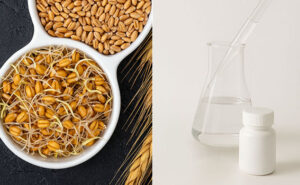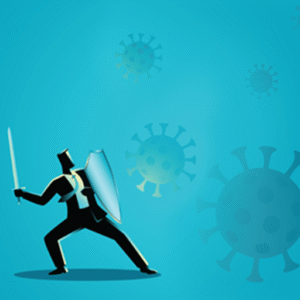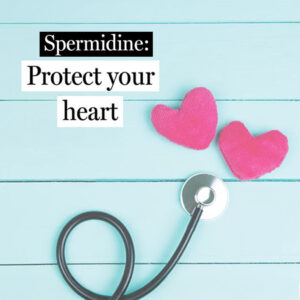Spermidine is gaining recognition as a powerful bioactive compound for supporting cardiovascular health and longevity. As cardiovascular disease remains the leading cause of death worldwide, scientists are exploring novel, naturally occurring compounds that can protect the heart and extend lifespan. Spermidine—a polyamine found in many fruits, vegetables, whole grains, and even produced endogenously—is emerging as a promising candidate. Research spanning animal models and human studies has highlighted its role in promoting heart health, reducing inflammation, extending lifespan, and improving overall cardiovascular function through mechanisms such as enhanced autophagy and improved mitochondrial performance. In this review, we bring together findings from several pivotal studies to help you understand the many benefits that spermidine offers for both cardiovascular health and aging.
Extending lifespan and protecting the heart
One of the landmark pieces of research comes from a 2016 study by Eisenberg et al. in Nature Medicine. In this study, researchers demonstrated that oral supplementation with spermidine not only extended the lifespan of mice but also provided significant cardioprotective benefits. Aging is commonly associated with cardiac hypertrophic remodeling, a structural and functional transformation of the heart characterized by an increase in cardiomyocyte (heart muscle cell) size and thickening of the heart walls. This process is often accompanied by a gradual decline in left ventricular diastolic function (how the heart relaxes and fills with blood after it contracts), leading to reduced cardiac efficiency and stiffness.

Spermidine’s role in cardioprotection
Spermidine provides overall protection to the heart by reducing oxidative stress, inflammation, and cellular damage.
Spermidine supplementation (i) promotes autophagy and mitophagy in cardiomyocytes; ii) improves mitochondrial volume and function; (iii) reduces chronic inflammation (circulating TNFα levels); (iv) improves systemic arginine bioavailability that may favor the production of the vasodilator nitric oxide (NO), and thus decrease systemic blood pressure; (v) decreases left ventricle hypertrophy; and (vi) increases titin phosphorylation which improves the mechano-elastical properties of cardiomyocytes. Cardiomyocyte: heart muscle cells that contract to pump blood. Blood vessel: includes arteries and veins, which transport blood throughout the body. Titin: a spring-like protein in muscle cells that ensures smooth stretching and contracting when it’s properly phosphorylated. Arginine: an amino acid precursor to NO and spermidine. Adapted from Eisenberg et al., 2017. © 2025 Melissa Cano. All rights reserved.
Dietary polyamines and cardiovascular mortality
Before these cellular insights, a 2012 study published in the Global Journal of Health Science examined the relationship between dietary polyamines (including spermidine and its relative, spermine) and CVD mortality across 48 European and Western countries. Using food supply data and polyamine concentrations in various foods, researchers found that higher dietary intake of these polyamines was linked to lower rates of cardiovascular death. This large-scale analysis also noted that factors like higher GDP and increased consumption of fruits, vegetables, nuts, and beans were associated with better cardiovascular outcomes—while smoking and whole milk consumption had the opposite effect.
A closer look in the heart
Spermidine and aortic health
Peripheral artery disease and autophagy activation
A 2022 pilot study in Antioxidant examined a mixture of autophagy activators, including spermidine, in patients with peripheral artery disease (PAD, a specific type of atherosclerosis which occurs in the legs). After 60 days, patients receiving the mixture experienced a 91% increase in maximal walking distance, alongside improvements in oxidative stress markers and autophagic activity. These results indicate spermidine’s potential in improving vascular function and reducing oxidative stress in PAD patients.
Prevention of aortic aneurysms
A 2020 study in Journal of the American Heart Association investigated spermidine’s effects on experimental abdominal aortic aneurysms (AAAs, bulges in the aorta that can lead to its rupture) in mice. Spermidine treatment preserved aortic structural integrity, reduced inflammation, and increased autophagy-related proteins, suggesting its promise in preventing aneurysm progression.
Several studies have explored spermidine’s role in mitochondrial health. A 2020 study in Aging found that spermidine supplementation in aged rats improved mitochondrial biogenesis by activating the SIRT1/PGC-1α signaling pathway (PGC-1α is a master regulator of mitochondrial biogenesis), preserving myocardial structure and function. A 2021 study in Journal of Anatomy similarly demonstrated that spermidine supplementation increased mitochondrial numbers in aged mice and improved their structural alignment, suggesting that spermidine helps maintain mitochondrial integrity in aging hearts.
The role of spermidine in arterial aging and endothelial function
A 2013 study in Mechanism of Ageing and Development showed that spermidine supplementation reduced arterial stiffness in aged mice (the loss of elasticity in the arteries leading to CVD, primarily caused by aging). It also improved endothelial function (the ability of the thin layer of cells lining the blood vessels to properly control blood flow) by enhancing autophagy and increasing NO production. A 2023 study in Scientific Reports further supported these findings, showing that spermidine improved angiogenesis (the development of new blood vessels) and neovascularization in ischemic limbs (the development of small blood vessels to compensate for impaired blood flow) of aged mice by enhancing autophagy and mitochondrial function. Similarly, a 2017 study in Oncotarget reported that both spermidine and its relative spermine reversed age-related myocardial alterations in rats, reduced fibrosis (the overgrowth of scar tissue that can affect organ function), and decreased apoptosis (cell death), further suggesting that polyamines can modulate key pathways involved in cardiac deterioration.
Mechanisms underlying spermidine’s cardioprotective effects
Across these studies, several recurring mechanisms emerge:
- Enhanced autophagy and mitophagy: Spermidine consistently stimulates cellular recycling processes, which help clear damaged organelles and proteins, leading to improved cell survival and function.
- Improved mitochondrial function: Many studies show that spermidine restores mitochondrial biogenesis and quality, ensuring that cardiomyocytes maintain their energy supply and structural integrity.
- Anti-inflammatory and antioxidant effects: By reducing oxidative stress and systemic inflammation, spermidine contributes to healthier blood vessels and less plaque instability.
- Gut microbiota interactions: The modulation of gut bacterial metabolism can increase endogenous spermidine production, offering an additional layer of cardiovascular protection.
Conclusion : you can protect your heart with spermidine
Spermidine has emerged as a powerful and versatile nutraceutical with significant potential to support cardiovascular health and promote longevity. Through its ability to enhance autophagy, improve mitochondrial function, reduce oxidative stress, and modulate inflammation, spermidine addresses multiple hallmarks of CVD. Studies spanning animal models and human populations have demonstrated its cardioprotective effects, including reducing cardiac hypertrophy, stabilizing atherosclerotic plaques, preventing vascular calcification, and improving endothelial function. Furthermore, spermidine’s interaction with the gut microbiota adds another layer of complexity to its benefits, suggesting a holistic approach to cardiovascular health.
For those looking to support their heart health naturally, incorporating spermidine-rich foods—such as whole grains, legumes, aged cheeses, and mushrooms—into the diet may offer a simple yet effective strategy. Additionally, spermidine supplementation could provide a targeted approach for individuals at risk of CVD or those seeking to optimize their longevity. While further clinical trials are needed to fully establish its therapeutic potential, the current body of evidence positions spermidine as a promising candidate for the prevention and management of CVD.
Tackling this global health challenge demands a multifaceted approach, including public health interventions, lifestyle changes, and improved healthcare access. In this context, spermidine emerges as a natural, science-backed ally, offering a promising strategy to support heart health and enhance both lifespan and healthspan, helping to combat the growing threat of heart disease.
References:







